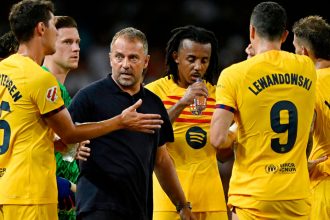Brad Haddin is finally filling Adam Gilchrist’s vast shoes as Australia’s keeper, but he’s not about to let his predecessor’s reputation overwhelm him. “It’s important that you leave your own mark on the team,” he says
Brydon Coverdale03-Sep-2008
Them’s the breaks: Haddin nearly let his chance at the Australia job fall when he sustained a finger injury in his first Test © Getty Images
It took Brad Haddin seven years to win a spot in Australia’s Test team andless than a fortnight to almost lose it. The chance nearly slipped throughhis slightly gnarled fingers when one of those digits broke during his debutin the West Indies in May. But vacant Test wicketkeeping spots have beenrarer than terry-towelling hats in Australian cricket in recent years andHaddin was not about to let a snapped finger shatter his dream.He had spent so long in Adam Gilchrist’s shadow that when Gilchrist retiredand Haddin had three months to prepare for his Test call-up, he plannedmeticulously to ensure it would be a success. That included ignoring thechance to play for big money in the Indian Premier League, instead gettinghimself physically and mentally ready for Test cricket. That made it all themore maddening when his right ring finger fractured.”I’d be lying to say it wasn’t frustrating,” Haddin said. “But it’s one ofthose things that you can’t really let it get you down for too long becauseyou can’t really control what happens out there.”He ploughed on through the second Test before an infection added to theannoyance. There was a very real chance Haddin’s career would stall at twoTests, and the selectors rushed the Western Australia gloveman Luke Ronchi toBarbados as a back-up. Haddin was only saved by a lengthy gap between games.”After the second Test I sort of felt a little bit uncomfortable,” he said.”I might have been touch and go for the third but we were lucky enough tohave eight days off, which helped just get the infection out of the hand.”He knew how Ronchi felt. In 2001, Haddin was flown to India during a Testseries but Gilchrist proved immovable despite having an injured hip. One-daycaps have been more readily distributed, and when the finger began affectingHaddin’s performance in the Caribbean he handed over the gloves to Ronchifor the limited-overs games.Ronchi’s athletic keeping and breathtaking strikes – he thumped a 22-ballhalf-century in the fifth ODI – may have closed the gap between theincumbent and the No. 2. Haddin insists his replacement’s success did notfaze him and he was fully prepared to give up his spot again for the nowpostponed Champions Trophy. His wife Karina is due to give birth onSeptember 10 and regardless of where his team-mates are at the time, Haddinis planning to be right by her side.”There was no way I was going to miss the birth,” Haddin said. “I was alwaysgoing to be there for Karina and it’s something you don’t want to miss, thebirth of your first child. It hadn’t crossed my mind. I was always going to be at the birth, as simple as that.”The thought brought a gentle smile to Haddin’s otherwise weary face as hesat in the stands at Darwin’s Marrara Cricket Ground after a drainingstrength and conditioning workout between ODIs against Bangladesh. His kneesheavily strapped with ice, Haddin surveyed a ground that looked more like asmall-town oval than an international venue, with plenty of grassyembankments for the locals to bring their own deck-chairs and sit and watchwith beer in hand.It would be a familiar sight for Haddin, who grew up in country New SouthWales. His father is a carpenter who also ran a pub in the small town ofGundagai – population: 2000 – before the family moved to the marginallylarger community of Queanbeyan, just outside the Australian CapitalTerritory. It was a thoroughly sporting family; Haddin’s two youngerbrothers are now personal trainers and the three siblings have their ownfitness company. Haddin insists his replacement Ronchi’s success did not faze him and he was fully prepared to give up his spot again for the now postponed Champions Trophy Haddin was fortunate to be virtually an ACT local when the Canberra Cometsappeared in the domestic one-day competition in 1997-98. The team lastedonly three years but Haddin was so impressive – he was the only man to makea century for them – that he was pinched by New South Wales after twoseasons.”That was one of the most important times in my cricket career,” Haddinsaid. “A lot of guys at my age – I was 18, 19 – didn’t have the luxury ofbeing exposed to first-class cricket that young, and with the Canberra Cometscoming in I was lucky. Just seeing the standard of first-class cricket atsuch a young age and I think it’s contributed a lot to where my cricket hasgot to now.”Back in those days the incumbent Australian wicketkeeper, Ian Healy, wasHaddin’s cricketing idol. This week in Darwin, Haddin’s glovework wasclosely watched in the nets by Healy, in town for his commentating duties,while the Australia coach, Tim Nielsen, gave Haddin some throwdowns.Nielsen is the latest in a line of former wicketkeepers who have mentoredHaddin, including Steve Rixon, and Trevor Bayliss, the occasional keeper atNew South Wales. But Haddin is careful to remain his own man, a lesson thathe learnt early in his career. It was reinforced when he came in for theincomparable Gilchrist in the Test outfit.”You come in and you’re replacing one of the legends of the game but it’simportant that you leave your own mark on the team,” Haddin said. “You’vegot to make sure and be honest with yourself. Everyone brings differentthings to a side and you can’t be something you’re not. It’s important justto be yourself.”And not to break too many fingers.






